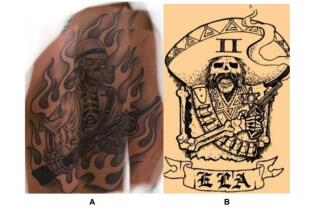Ruling Has Made It Harder to Lock Up Taggers
- Share via
To avoid a potential three-year state prison sentence, John Azim Lake, a.k.a. Siva, pleaded guilty in 1995 to one felony count of vandalism. Lake had been accused of 28 taggings in Sherman Oaks over a 13-month period.
Although each tag caused no more than several hundred dollars--or misdemeanor amounts--in damage, prosecutors were able to total the damages--an estimated $34,000--and charge Lake with felony vandalism. He was sentenced to nine months in county jail and ordered to pay restitution.
Had the case been processed today, prosecutors said they would be lucky if Lake pleaded guilty to more than a few misdemeanors. And the threat of a state prison sentence would be nonexistent.
A January 1997 appeals court decision overturned the practice of aggregating--or adding up--separate misdemeanor counts of vandalism and converting them into a felony charge. The ruling has left law enforcement officials and state lawmakers grappling with how to fairly punish prolific taggers.
“My hands are tied by law,” said Det. Jerry Beck, coordinator of the Community Tagger Task Force in Van Nuys. The task force is a joint effort of private citizens and police officers that works to identify taggers.
Cities, schools and other agencies in Los Angeles County alone spent $150 million to clean graffiti in 1995, the most recent figure available, according to Paul Racs, assistant director of Operation Clean Sweep, the city’s primary graffiti eradicator. Every month, for example, the Metropolitan Transportation Authority spends more than $1 million just to wipe clean its buses and other vehicles, while Caltrans spends about $3 million a year to clean up Los Angeles-area freeways.
Nationwide, the graffiti-cleanup figure is about $7 billion.
Individually, an incident of tagging rarely causes more than a few hundred dollars in damage, far below the $5,000 minimum required to bring a felony charge, said Ivor Alan-Lee, who coordinates volunteers for the Community Tagger Task Force.
The decision in The People vs. David D. said prosecutors could no longer aggregate, because each incident is its own “transaction,” has different victims and is not part of an overall plan or scheme.
This created a loophole, Beck said, for those taggers who cause the most damage.
*
In each of the past two legislative sessions, state lawmakers have presented bills to legalize vandalism aggregation. But members of the Senate public safety committee blocked the proposed legislation each time, voicing concerns about the state’s overburdened prison system and the bill’s three-strikes implications.
Assemblyman Martin Gallegos (D-Baldwin Park) introduced a bill earlier this year that allowed prosecutors to add up damage amounts to meet the felony threshold. The proposal passed in the Assembly, but died in the Senate public safety committee in June.
During his days on the Baldwin Park City Council, Gallegos said he saw firsthand the economic strain that removing graffiti can place on a community.
“We spent $250,000 on graffiti cleanup. That money could have gone to good use,” he said, adding that the money could have been spent for “paying the salaries of four new police officers or funding extra recreation or youth programs.”
Last year, state Sen. Adam Schiff (D-Burbank) introduced a similar bill. It was about to die in the Senate committee, so Schiff amended it to get rid of aggregation. The bill signed into law added penalties of 300 hours of community service for taggers and doubled fines and jail sentences for repeat offenders.
Schiff said the Legislature’s unwillingness to further punish quality-of-life crimes sends a message “that you can go ahead and commit offenses and we’ll look the other way until you do something really bad.”
Opposition to both bills came from the California Public Defenders Assn. and the California Attorneys for Criminal Justice. Kathy Sher, CACJ’s legislative lobbyist, said there is no need for a new law. “We have some fairly stiff penalties available under existing law for graffiti,” she said.
*
Taggers are typically charged with misdemeanor vandalism. The maximum sentence for causing less than $400 in damage is six months in county jail and a $1,000 fine. A felony charge--for causing $5,000 to $50,000 in damage in a single incident--can result in one year in state prison and a $10,000 fine.
Both camps agree that allowing aggregation would result in more convictions.
“It’s not so much the actual aggregation of graffiti offenses that the Senate Public Safety Committee was concerned about--it was creating additional burdens on the prison system for nonviolent offenders,” Gallegos said. “So essentially, the direction by the leadership of the Senate was there would be no new felonies created for nonviolent offenses.”
State senators who voted against the bill, such as John Vasconcellos (D-Santa Clara), were also hesitant to create a new nonviolent felony that theoretically could result in a three-strikes conviction and life sentence, according to Rand Martin, Vasconcellos’ chief of staff.
“It has been his position as public safety chair that adding a felony simply adds to the inherent problem of our three-strikes law,” Martin said, “so he does not want to add additional felonies.”
Gallegos said he may try to introduce a modified version of his unsuccessful bill that makes it a “wobbler--at the discretion of the district attorney and judge to decide whether a case warrants being a felony,” he said.
In the meantime, the city attorney’s office, which prosecutes misdemeanors, has stepped up and pushed for the toughest penalties allowed by law, Det. Beck said. But he’s still disappointed by the Legislature’s failure to adopt Gallegos’ bill or the one originally proposed by Schiff.
“The citizens don’t get satisfaction,” Beck said. “It’s a shame that politics are getting put ahead of the citizens.”
More to Read
Sign up for Essential California
The most important California stories and recommendations in your inbox every morning.
You may occasionally receive promotional content from the Los Angeles Times.














